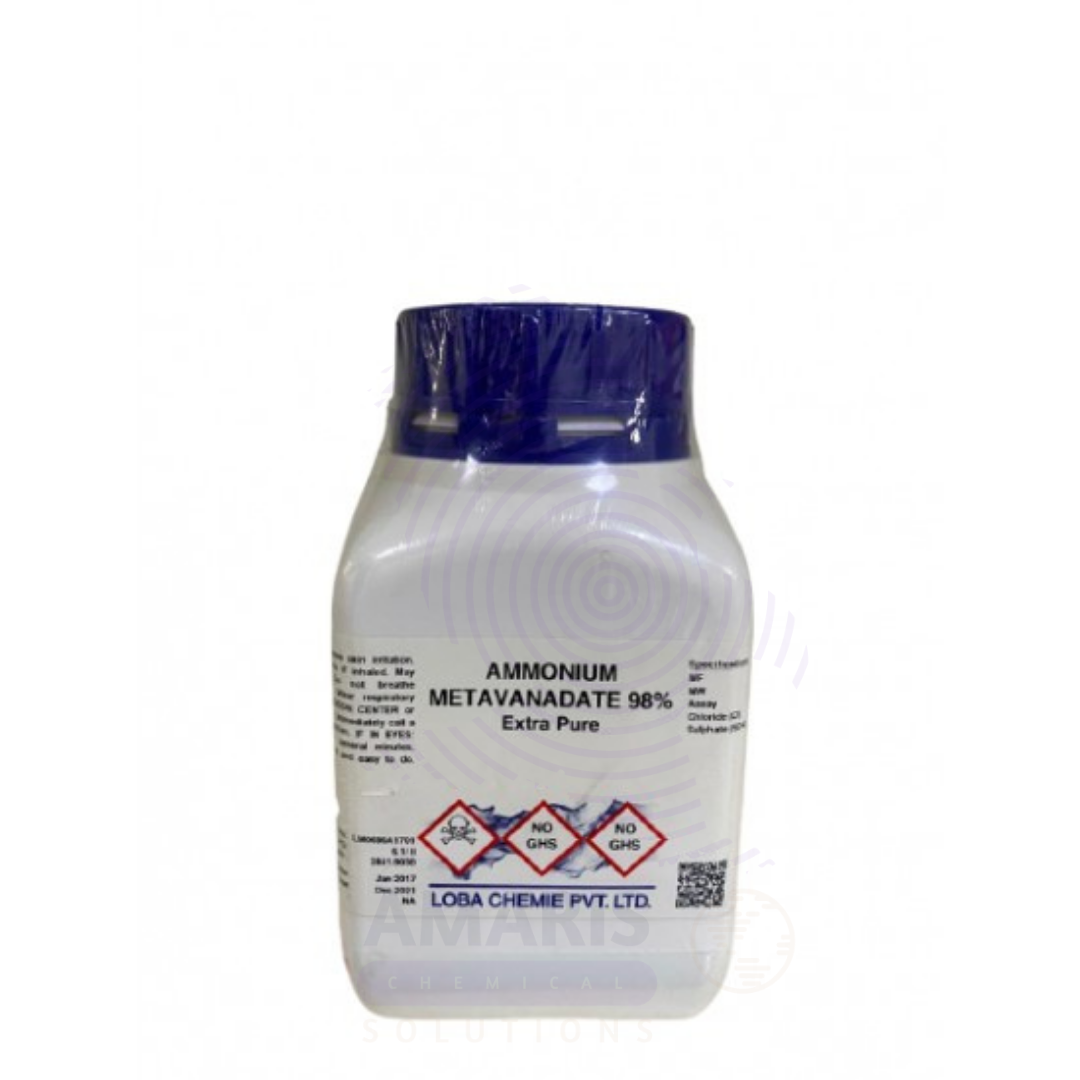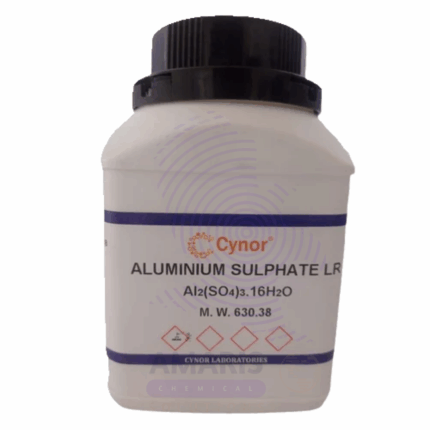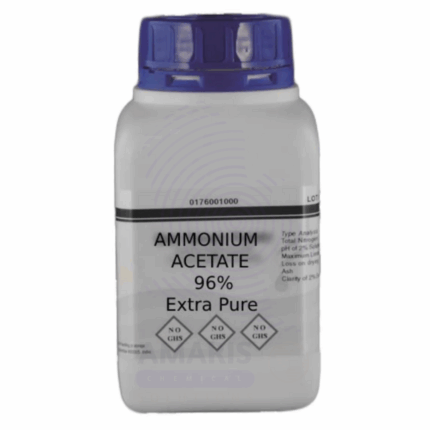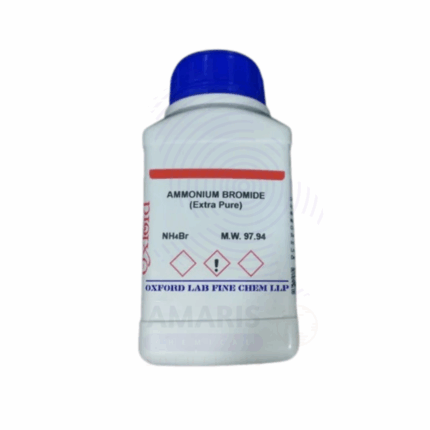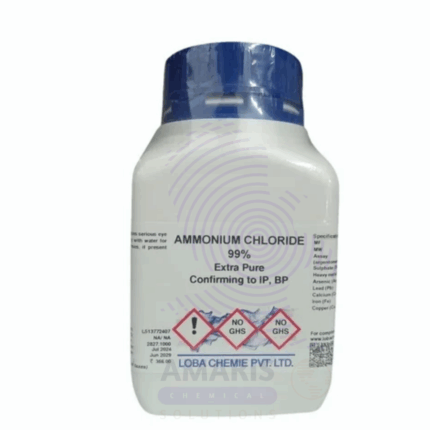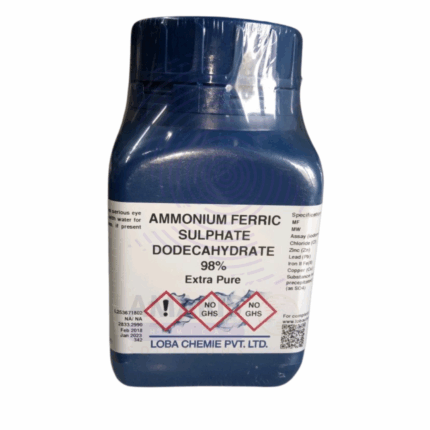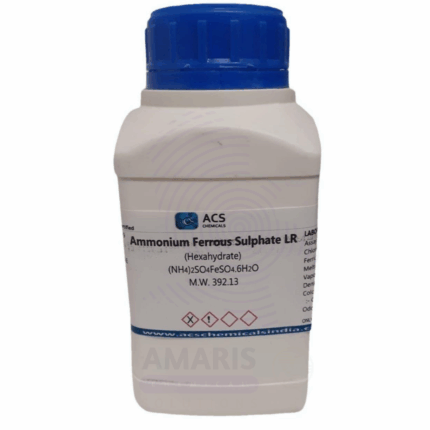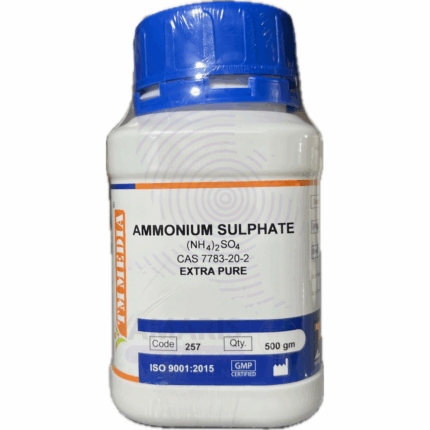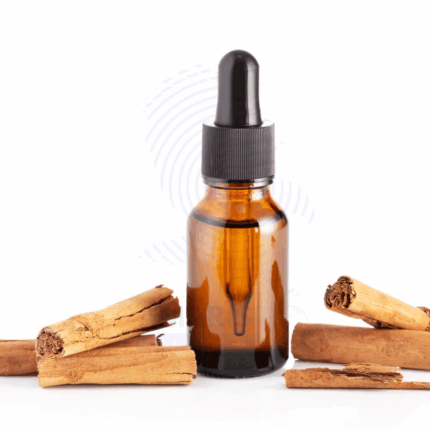
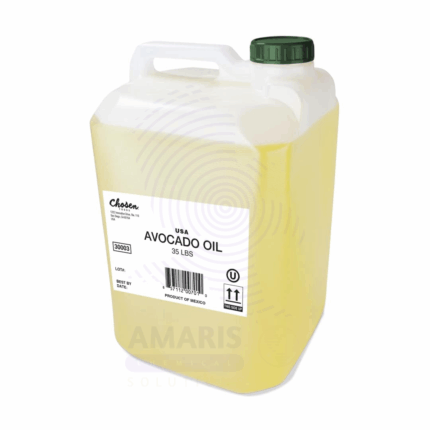
Ammonium Vanadate Extra Pure
$ 18.00 Original price was: $ 18.00.$ 17.34Current price is: $ 17.34.
Ammonium Vanadate Extra Pure is a high-purity, yellow crystalline compound primarily used in laboratory settings for analytical, inorganic, and catalytic research. It serves as a reliable source of vanadium in oxidation-reduction studies, and is especially valuable in colorimetric analysis of phosphates and peroxides, where it forms distinct vanadate complexes. In catalysis, it is used as a precursor for vanadium-based catalysts in oxidation reactions and materials synthesis. The extra pure grade ensures minimal contamination, making it suitable for high-precision experimental work. Due to its toxic and oxidative nature, it should be handled with care and stored in a cool, dry place in tightly sealed containers, away from incompatible substances.
Ammonium Vanadate Extra Pure
Primary Uses
- Reagent in Colorimetric Phosphate Determination
- Forms a yellow vanadomolybdate complex with phosphate and ammonium molybdate — used in spectrophotometric determination of phosphate in water, food, and soil samples.
- Oxidizing Agent in Redox Reactions
- Provides vanadium in the +5 oxidation state, making it a powerful oxidizer in both organic and inorganic redox reactions.
- Source of Vanadium(V) in Coordination Chemistry
- Used in the synthesis of polyoxovanadates and vanadium complexes for structure, reactivity, and catalysis studies.
- Component in Mixed-Valence Redox Studies
- Helps investigate V(V)/V(IV)/V(III) redox cycling, making it valuable for electrochemical or redox titration experiments.
- Demonstration of Transition Metal Colors and Redox Behavior
- Displays distinct color changes across oxidation states (yellow → blue → green) — ideal for educational redox demonstrations.
Secondary Uses
- Catalyst Precursor in Oxidation Chemistry
- Used to generate vanadium oxides and supported vanadium catalysts in lab-scale oxidation of alcohols or hydrocarbons.
- Model Compound in Environmental Studies
- Employed in studies of vanadium mobility, toxicity, and speciation in environmental or soil chemistry.
- Crystal Growth and Structural Inorganic Chemistry
- It forms part of the starting material for growing vanadate-based crystals for X-ray diffraction and lattice geometry studies.
- Reagent in Preparation of Other Vanadium Compounds
- Converts to vanadium pentoxide (V₂O₅) and other vanadates for advanced material synthesis.
- Study of Acid–Base Equilibria in Polyoxometalate Chemistry
- Used in pH-dependent equilibria of metavanadates and decavanadates in advanced inorganic labs.
| PACK SIZE |
500 grams Plastic Tin |
|---|
1. Basic Identification Attributes
- Chemical Name: Ammonium Metavanadate
- CAS Number: 7803-55-6
- HS Code: 28417000 (Vanadates, including ammonium vanadate)
- Molecular Formula: NH₄VO₃
- Synonyms:
- Ammonium vanadate
- Ammonium metavanadate
- Vanadic acid, ammonium salt
- Ammonium trioxovanadate(V)
2. Physical & Chemical Properties
- Physical State: Solid (crystalline powder)
- Color & Odor: Yellow to off-white powder; odorless
- Boiling Point: Decomposes before boiling
- Melting Point: Decomposes at ~200 °C
- Density/Specific Gravity: ~2.33 g/cm³
- Solubility:
- Water: Slightly soluble (~5.4 g/100 mL at 20 °C)
- Alcohol: Insoluble
- pH Level: ~6–8 (weakly basic in dilute aqueous solution)
- Vapor Pressure: Negligible
- Flash Point: Not flammable
- Autoignition Temperature: Not applicable
- Viscosity: Not applicable
3. Safety & Hazard Attributes
- Hazard Class (GHS):
- Acute Toxicity – Oral (Category 3)
- Acute Toxicity – Inhalation (Category 3)
- Skin & Eye Irritation (Category 2)
- Specific Target Organ Toxicity – Repeated Exposure (Category 2: blood, lungs)
- Aquatic Chronic (Category 1)
- NFPA Ratings:
- Health: 3
- Flammability: 0
- Reactivity: 1
- Exposure Limits:
- OSHA PEL (as vanadium pentoxide dust): 0.5 mg/m³ (ceiling)
- ACGIH TLV: 0.05 mg/m³ (respirable fraction, V₂O₅ as vanadium)
- Reactivity:
- Oxidizing agent; may react with reducing agents
- Sensitive to strong acids and bases
4. Storage & Handling Attributes
- Storage Conditions:
- Store in tightly sealed container in a cool, dry, ventilated area
- Protect from moisture and light
- Incompatible Materials:
- Strong reducing agents, acids, organic materials
- Container Type:
- Amber glass or plastic container
- Shelf Life & Expiration Date:
- ~2–3 years when properly stored
- Special Handling Requirements:
- Use gloves, eye protection, and dust mask
- Handle in fume hood to avoid inhalation of dust or decomposition vapors
5. Regulatory & Compliance Attributes
- Regulatory Status:
- Listed in TSCA, REACH
- Regulated as a toxic compound due to vanadium content
- Transportation Restrictions:
- Not regulated under standard UN classifications in lab quantities
- Waste Disposal Method:
- Collect as hazardous waste (toxic metal content)
- Do not dispose down the drain
6. Environmental & Health Impact
- Ecotoxicity:
- Very toxic to aquatic life with long-lasting effects
- Persistence in Environment:
- Not readily biodegradable; vanadium is environmentally persistent
- Carcinogenicity/Mutagenicity:
- Not definitively classified, but vanadium compounds may pose carcinogenic risk with long exposure
- Biodegradability:
- Inorganic; not biodegradable
SAFETY PRECAUTIONS
- Personal Protective Equipment (PPE):
- Wear a lab coat, chemical splash goggles, and nitrile or neoprene gloves.
- Use only in a fume hood or well-ventilated area to avoid inhaling dust or vapors.
- Handling:
- Handle with extreme care—ammonium vanadate is toxic and suspected carcinogen.
- Avoid inhalation, skin, and eye contact.
- Do not ingest or allow prolonged exposure.
- Avoid contact with acids, reducing agents, and combustible materials.
- Storage:
- Store in a tightly sealed container in a cool, dry, well-ventilated place.
- Keep away from acids, heat, light, and incompatible materials.
- Label container clearly with hazard warnings.
- Hygiene Measures:
- Wash hands thoroughly after handling.
- Decontaminate all surfaces and equipment after use.
- Do not eat, drink, or smoke in the work area.
FIRST AID MEASURES
- Inhalation:
- Move the person to fresh air immediately.
- If breathing is difficult, provide oxygen and seek emergency medical help.
- Inhalation may cause lung irritation, coughing, and systemic toxicity.
- Skin Contact:
- Remove contaminated clothing.
- Wash skin thoroughly with soap and water.
- Seek medical attention for signs of irritation or delayed symptoms.
- Eye Contact:
- Rinse cautiously with plenty of water for at least 15 minutes.
- Remove contact lenses if present.
- Seek immediate medical attention—may cause serious eye irritation.
- Ingestion:
- Rinse mouth thoroughly with water.
- Do not induce vomiting.
- Seek immediate medical help — vanadium compounds can cause gastrointestinal and systemic toxicity (e.g., nausea, cramps, kidney or liver effects).
FIRE FIGHTING MEASURES
- Suitable Extinguishing Media:
- Use dry chemical, carbon dioxide (CO₂), foam, or water spray, depending on the fire context.
- Specific Hazards:
- Not flammable, but may decompose on heating, emitting:
- Ammonia
- Nitrogen oxides (NOₓ)
- Vanadium oxides (toxic)
- Not flammable, but may decompose on heating, emitting:
- Protective Equipment for Firefighters:
- Use self-contained breathing apparatus (SCBA) and full protective clothing.
- Firefighting Instructions:
- Avoid breathing smoke, dust, or decomposition fumes.
- Prevent runoff—toxic to aquatic life and soil.
- Cool containers exposed to fire with water spray.


 Preservatives(food)
Preservatives(food) Flavor Enhancers
Flavor Enhancers Acidulants
Acidulants Sweeteners
Sweeteners Antioxidants
Antioxidants Colorants(food)
Colorants(food) Nutraceutical Ingredients (food)
Nutraceutical Ingredients (food) Nutrient Supplements
Nutrient Supplements Emulsifiers
Emulsifiers
 Collectors
Collectors Dust Suppressants
Dust Suppressants Explosives and Blasting Agents
Explosives and Blasting Agents Flocculants and Coagulants
Flocculants and Coagulants Frothers
Frothers Leaching Agents
Leaching Agents pH Modifiers
pH Modifiers Precious Metal Extraction Agents
Precious Metal Extraction Agents
 Antioxidants(plastic)
Antioxidants(plastic) Colorants (Pigments, Dyes)
Colorants (Pigments, Dyes) Fillers and Reinforcements
Fillers and Reinforcements Flame Retardants
Flame Retardants Monomers
Monomers Plasticizers
Plasticizers Polymerization Initiators
Polymerization Initiators Stabilizers (UV, Heat)
Stabilizers (UV, Heat)
 Antifoaming Agents
Antifoaming Agents Chelating Agents
Chelating Agents Coagulants and Flocculants
Coagulants and Flocculants Corrosion Inhibitors
Corrosion Inhibitors Disinfectants and Biocides
Disinfectants and Biocides Oxidizing Agents
Oxidizing Agents pH Adjusters
pH Adjusters Scale Inhibitors( water)
Scale Inhibitors( water)
 Antioxidants(cosmetic)
Antioxidants(cosmetic) Emollients
Emollients Fragrances and Essential Oils
Fragrances and Essential Oils Humectants
Humectants Preservatives
Preservatives Surfactants(cosmetic)
Surfactants(cosmetic) Thickeners
Thickeners UV Filters
UV Filters
 Fertilizers
Fertilizers Soil Conditioners
Soil Conditioners Plant Growth Regulators
Plant Growth Regulators Animal Feed Additives
Animal Feed Additives Biostimulants
Biostimulants Pesticides (Herbicides, Insecticides, Fungicides)
Pesticides (Herbicides, Insecticides, Fungicides)
 Active Pharmaceutical Ingredients (APIs)
Active Pharmaceutical Ingredients (APIs) Excipients
Excipients Solvents(pharmaceutical)
Solvents(pharmaceutical) Antibiotics
Antibiotics Antiseptics and Disinfectants
Antiseptics and Disinfectants Vaccine Adjuvants
Vaccine Adjuvants Nutraceutical Ingredients (pharmaceutical)
Nutraceutical Ingredients (pharmaceutical) Analgesics & Antipyretics
Analgesics & Antipyretics
 Analytical Reagents
Analytical Reagents Solvents(lab)
Solvents(lab) Chromatography Chemicals
Chromatography Chemicals Spectroscopy Reagents
Spectroscopy Reagents microbiology-and-cell-culture-reagents
microbiology-and-cell-culture-reagents Molecular Biology Reagents
Molecular Biology Reagents Biochemical Reagents
Biochemical Reagents Inorganic and Organic Standards
Inorganic and Organic Standards Laboratory Safety Chemicals
Laboratory Safety Chemicals Specialty Laboratory Chemicals(Special Laboratory Equipment)
Specialty Laboratory Chemicals(Special Laboratory Equipment)
 Demulsifiers
Demulsifiers Hydraulic Fracturing Fluids
Hydraulic Fracturing Fluids Scale Inhibitors(oil)
Scale Inhibitors(oil) Surfactants(oil)
Surfactants(oil) Drilling Fluids
Drilling Fluids
 Dyes and Pigments
Dyes and Pigments Bleaching Agents
Bleaching Agents Softening Agents
Softening Agents Finishing Agents
Finishing Agents Antistatic Agents
Antistatic Agents
 Admixtures
Admixtures Waterproofing Agents
Waterproofing Agents Sealants and Adhesives
Sealants and Adhesives Curing Compounds
Curing Compounds Concrete Repair Chemicals
Concrete Repair Chemicals Anti-Corrosion Coatings
Anti-Corrosion Coatings
 Surfactants(cleaning)
Surfactants(cleaning) Builders
Builders Enzymes
Enzymes Solvents (Cleaning)
Solvents (Cleaning) Fragrances
Fragrances
 Electronic Chemicals
Electronic Chemicals Catalysts
Catalysts Lubricants
Lubricants Photographic Chemicals
Photographic Chemicals Refrigerants
Refrigerants Automotive chemicals
Automotive chemicals Pyrotechnic Chemicals
Pyrotechnic Chemicals
 Biodegradable Surfactants
Biodegradable Surfactants Bio-based Solvents
Bio-based Solvents Renewable Polymers
Renewable Polymers Carbon Capture Chemicals
Carbon Capture Chemicals Wastewater Treatment Chemicals
Wastewater Treatment Chemicals
 Pigments
Pigments Solvents(paint)
Solvents(paint) Specialty Coatings
Specialty Coatings Binders/Resins
Binders/Resins Additives
Additives Driers
Driers Anti-Corrosion Agents
Anti-Corrosion Agents Functional Coatings
Functional Coatings Application-Specific Coatings
Application-Specific Coatings
 Fresh Herbs
Fresh Herbs Ground Spices
Ground Spices Whole Spices
Whole Spices Spice Blends
Spice Blends Dried Herbs
Dried Herbs
 Leavening Agents
Leavening Agents Dough Conditioners
Dough Conditioners Flour Treatments
Flour Treatments Fat Replacers
Fat Replacers Decoratives
Decoratives Preservatives(baking)
Preservatives(baking)
 Plasticizers & Softeners
Plasticizers & Softeners Reinforcing Agents
Reinforcing Agents Adhesion Promoters
Adhesion Promoters Vulcanizing Agents
Vulcanizing Agents Antidegradants
Antidegradants Blowing Agents
Blowing Agents Fillers & Extenders
Fillers & Extenders Accelerators & Retarders
Accelerators & Retarders